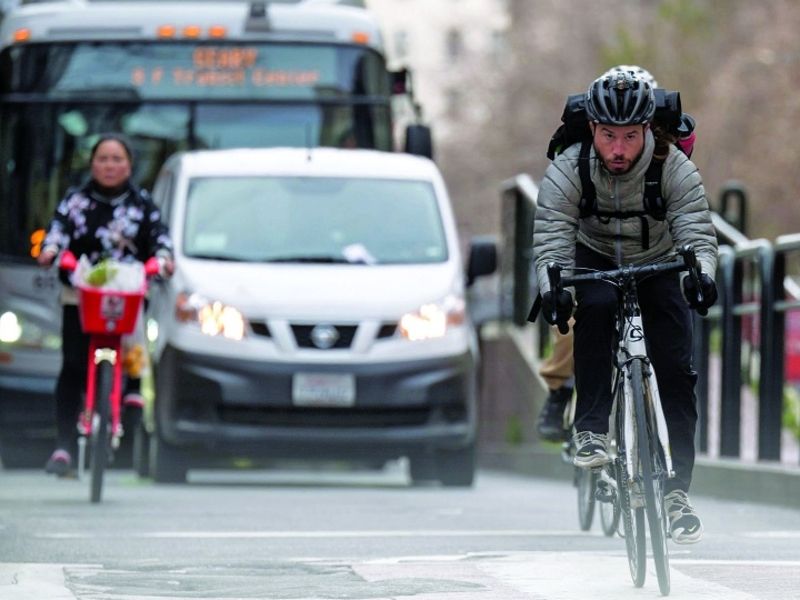
Vehicles can interact with other vehicles, infrastructure and pedestrians through CV2X, or cellular vehicle-to-everything technology.
One group of industry leaders is seeking to expand on the idea behind this technology by creating standards to make safer the interactions between cars and other kinds of wheels on the road: bicycles.
Michigan-based Tome Software, bicycle company Trek, Ford Motor Co. — which owns e-scooter company Spin — and other partners have been collaborating on B2V, or bicycle-to-vehicle, guidelines to help vehicles communicate with bikes, scooters and roadside infrastructure related to cycling.
It’s an important collaboration considering the number of vulnerable road users, such as cyclists, pedestrians and scooter riders. It’s also timely given the increased interest in bike and scooter ridership since the onset of the pandemic last spring, said Eric Bjorling, brand marketing director at Trek.
“What you’ll see post-COVID is more of an awareness of the shared nature of transportation pathways, whether that’s roads, trails, streets,” Bjorling told Automotive News. “COVID has accelerated and accentuated the need for [B2V].”
Trek, Ford and Tome began working on B2V four years ago, a unique collaboration among a bike company, an automaker and a tech startup. The partners have since worked with others in the industry with similar goals for B2V standards.
“Without that structure, we felt strongly that you would not be able to get [B2V] deployed in production,” said Tome CEO Jake Sigal. “We’ve seen that in auto before with AV safety standards, but we haven’t seen much of that on the consumer side. And unlike automobiles, bicycles and scooters aren’t going to be regulated. There’s always going to be someone that’s going to be riding a vintage, 1979 Schwinn bicycle.”
Last month, Tome, Trek and Ford — along with auto supplier Bosch; cycling technology company Hammerhead; and bicycle components makers Shimano, Specialized and SRAM — joined SAE Industry Technologies, an affiliate of SAE International, to create a formal nine-member consortium.
“The key here is getting an agreeable standard framework for making changes to existing messages as well as what’s required or what’s optional,” Sigal said. “Nothing we’re doing will be required equipment on a vehicle or a bicycle. Having this technology is optional; but if you’re going to do it, and it’s going to be B2V-certified, then we need to agree on what are the minimum requirements you need in order to put B2V on packaging, per se.”
The challenge of creating these standards?
“Not only do you have to get the bicycle and consumer device companies like mobile phones, like accessory companies, to all agree on standards, you then also have to get vehicles to accept any sort of a framework for bringing in these messages,” Sigal said.
But, “instead of coming up with a new standard to develop, we’re basing our work on the existing standards that SAE has that already have industry-standard buy-in from the automotive industry.”
The group’s members are developing prototypes, some of which were demonstrated during CES last month.
Trek, for instance, is directly integrating B2V sensors into its taillight, which is designed to alert drivers of the presence of a cyclist.
Ford is testing the technology as part of its advanced driver-assistance system. Specialized is working to integrate B2V technology with its Ride cycling app.
The pandemic boosted bike and scooter ridership in cities around the globe. Increasing ridership has necessitated better infrastructure, such as more dedicated bike lanes in city centers, as well as greater focus on cyclist and rider safety.
“We think this bike boom is sustainable, and we think that this purchase boom is actually going to dovetail nicely into a riding boom,” Bjorling said. “This work becomes even more important now than ever before, in that you’re going to have more people on the roads in general.”